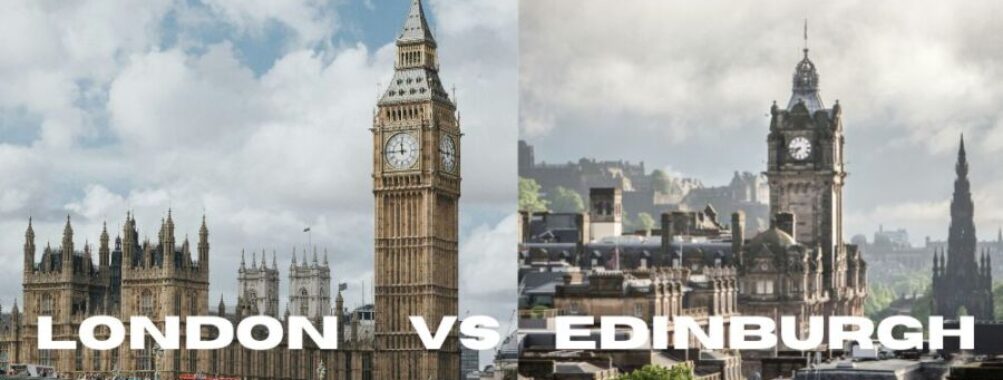
London vs Edinburgh: Which Historic Capital Offers Better Value?
London and Edinburgh stand as two of Britain’s most captivating cities, each with its own distinct charm and character. These historic capitals draw millions of tourists each year, making it tough to pick between them. Edinburgh tends to be the better choice for travelers seeking a mix of history, compact walkability, and easy access to nature, while London wins for its world-class museums, diverse neighborhoods, and endless entertainment options.
The Scottish capital offers rugged landscapes, medieval architecture, and a more laid-back pace of life. Its smaller size makes it perfect for short breaks where every minute counts. London dazzles with its grand palaces, modern attractions, and multicultural food scene – though its massive size can feel overwhelming for first-time visitors.
Contents
- Historical Overview and Landmarks
- Iconic Historical Sights in London
- Edinburgh’s Historical Depth
- Comparing Architectural Styles
- Cultural Experiences and Arts
- Arts Scene in London
- Cultural Festivities in Edinburgh
- Exploring Local Traditions
- Dining and Food Scenes
- Gourmet Dining in London
- Edinburgh’s Culinary Offers
- Accommodation and Living Expenses
- Hotel Accommodations in London
- Staying in Edinburgh
- Shopping and Marketplaces
- Retail Therapy in London
- Shopping Highlights in Edinburgh
- Transport and Accessibility
- Navigating London’s Public Transport
- Getting Around Edinburgh
- Parks and Nature
- Green Spaces in London
- Edinburgh’s Natural Attractions
- Frequently Asked Questions
- What distinguishes living costs between London and Edinburgh?
- How do the university experiences in Edinburgh compare to those in London?
- Which city should one choose for better employment opportunities, London or Edinburgh?
- In terms of cultural attractions and historical significance, how do London and Edinburgh differ?
- Can you compare the quality of life in Edinburgh versus London?
- Is the size and population density of Edinburgh more appealing than London’s for relocation?
- More Travel Guides
Historical Overview and Landmarks
London and Edinburgh showcase two unique sides of British history through their remarkable landmarks and architectural heritage. Each city tells its own fascinating story through castles, palaces, and centuries-old streets.
Iconic Historical Sights in London
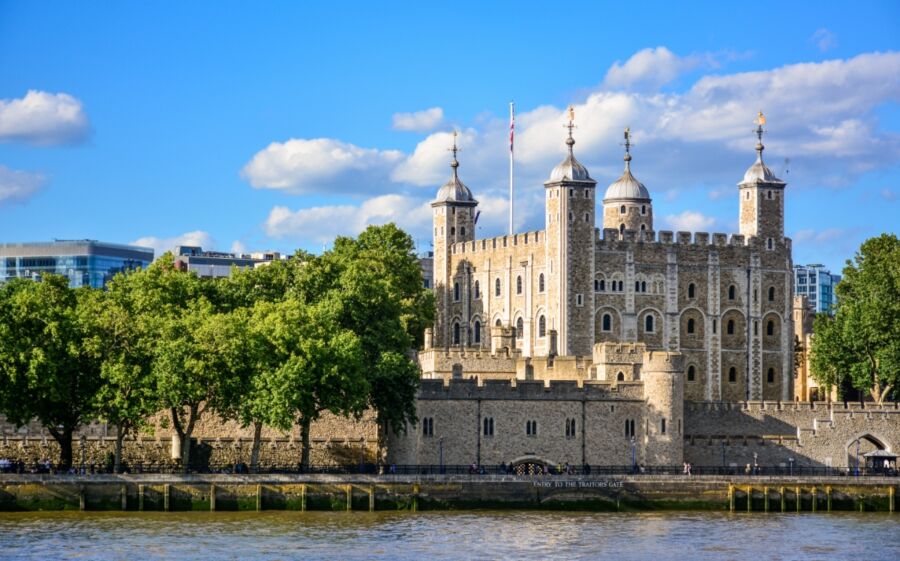
The Tower of London stands as a medieval fortress on the Thames, guarding the Crown Jewels and telling tales of royal intrigue dating back to 1066. The site has served as both a palace and a prison.
Big Ben and the Houses of Parliament represent Victorian Gothic architecture at its finest. The famous clock tower has kept time for Londoners since 1859.
Buckingham Palace became the official royal residence in 1837. The 775-room palace opens its State Rooms to visitors each summer, letting you peek into royal life.
Edinburgh’s Historical Depth

Edinburgh Castle dominates the city skyline from its perch on Castle Rock. This ancient fortress has withstood 26 sieges throughout Scottish history and houses the Scottish Crown Jewels.
The Royal Mile stretches from Edinburgh Castle to Holyroodhouse Palace. This historic street features medieval buildings, hidden closes (alleyways), and St Giles’ Cathedral with its distinctive crown spire.
The Palace of Holyroodhouse serves as the Queen’s official Scottish residence. Mary Queen of Scots lived here during her turbulent reign in the 16th century.
Comparing Architectural Styles
Edinburgh’s Old Town features narrow medieval streets and towering tenements built from dark stone. Many buildings date from the 16th and 17th centuries.
London mixes architectural periods, from medieval churches to modern skyscrapers. The city rebuilt extensively after the Great Fire of 1666, leading to more varied styles.
Georgian architecture appears in both cities. Edinburgh’s New Town showcases elegant townhouses and squares, while London’s Georgian buildings can be found in areas like Bloomsbury.
The cities differ in building materials. Edinburgh used local sandstone, giving it a unified appearance. London features more brick and Portland stone.
Cultural Experiences and Arts
Both cities offer rich artistic traditions and vibrant cultural scenes that showcase British heritage in different ways. London dazzles with world-class museums and theaters, while Edinburgh charms with its festivals and Scottish customs.
Arts Scene in London
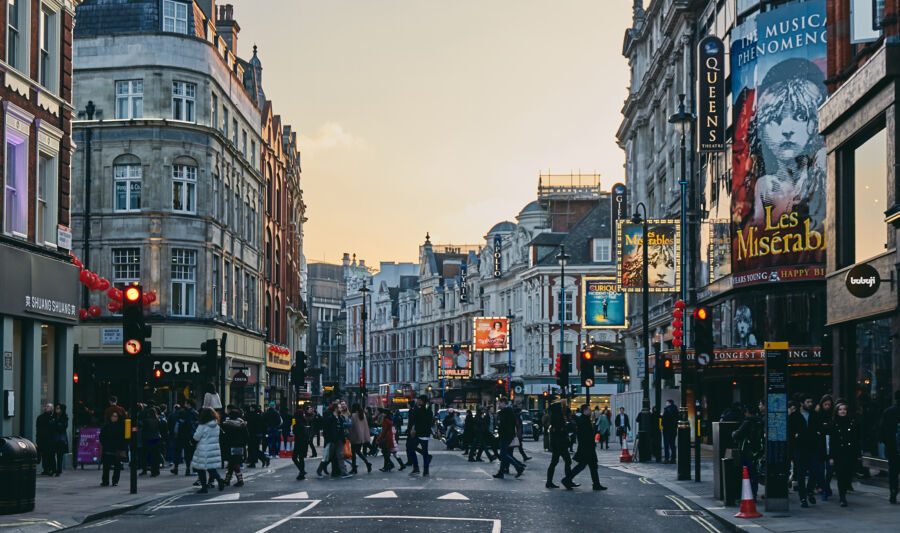
The West End lights up with famous musicals and plays every night. Theater lovers can watch top shows like Les Misérables or The Lion King in historic venues. Ticket prices range from £20 for upper seats to £150+ for premium spots.
The Tate Modern stands out as one of the world’s best modern art museums. Its massive turbine hall hosts eye-catching installations that change throughout the year. Entry is free for the main collections.
Live music fills venues across the city. From classical concerts at Royal Albert Hall to indie bands at Camden’s pubs, there’s music for every taste.
Cultural Festivities in Edinburgh

The Edinburgh Festival transforms the city each August. Streets fill with performers, comedians, and artists from around the globe. Book shows and accommodations early – the city gets very crowded.
The Royal Mile comes alive with street performers and bagpipers year-round. Traditional Scottish music sessions happen nightly in pubs like Sandy Bell’s and The Royal Oak.
The city embraces its Harry Potter connections. The cafes where J.K. Rowling wrote and the graveyards that inspired character names draw fans daily.
Exploring Local Traditions
Edinburgh keeps Scottish traditions front and center. Visitors can try haggis at historic pubs or sample rare whiskies at dedicated tasting rooms. Many shops sell authentic tartan goods and woolens.
London mixes old English customs with modern multiculturalism. Markets like Borough Market showcase traditional British foods alongside international cuisines.
Both cities offer cultural walking tours led by local experts. These tours help visitors understand the history and traditions that shaped each place.
Dining and Food Scenes
Both London and Edinburgh offer amazing dining experiences, from street food to high-end restaurants. Each city brings its own unique flavors and culinary traditions to the table.
Gourmet Dining in London

London stands as one of the world’s top food destinations. The city boasts over 60 Michelin-starred restaurants, including famous spots like The Ritz and Gordon Ramsay’s establishments.
The food scene reflects London’s diverse population. You’ll find authentic cuisines from India, China, Italy, and dozens more countries in neighborhoods across the city.
Traditional British dishes shine too. Many pubs serve classic fish and chips, while fancy hotels offer elegant afternoon tea with finger sandwiches and scones.
Edinburgh’s Culinary Offers

Edinburgh’s food scene has grown dramatically in recent years. The city now has 4 Michelin-starred restaurants that blend Scottish ingredients with modern cooking techniques.
Traditional Scottish fare takes center stage here. Local restaurants serve haggis, Angus beef, and fresh seafood from nearby waters. The wild game dishes feature pheasant and venison from the Highlands.
The Pitt Market brings Edinburgh’s best street food together on weekends. Visitors can try everything from Scottish street snacks to international dishes under twinkling lights in this industrial-style venue.
Several restaurants focus on farm-to-table dining, working with local producers to showcase Scotland’s fresh ingredients and centuries-old recipes with modern twists.
Accommodation and Living Expenses
Living costs differ greatly between these two major UK cities. Edinburgh offers better value with expenses about 34% lower than London, especially for housing and daily needs.
Hotel Accommodations in London

London’s luxury hotels set global standards for elegance. The Ritz stands as a symbol of British refinement, with rooms starting at £800 per night.
The Shard brings modern luxury to new heights, offering stunning views across the city. Rooms in mid-range London hotels typically cost £150-300 per night.
Budget travelers can find clean, basic rooms in London for £80-120 through [travel booking sites]. Hostels provide even cheaper options starting around £25 per night.
Staying in Edinburgh

The Balmoral Hotel represents Edinburgh’s finest accommodation, with rooms starting at £300 per night. Its location near Edinburgh Castle makes it ideal for sightseeing.
Mid-range hotels in Edinburgh cost £90-200 per night, offering significant savings compared to London equivalents.
Budget hotels and guesthouses in Edinburgh’s Old Town start at £60. Many provide cozy rooms in historic buildings with character.
Student areas like Newington offer the best deals on short-term rentals. A one-bedroom flat costs around £800 monthly compared to London’s £1,700 average.
Shopping and Marketplaces
London and Edinburgh offer unique retail experiences, from historic markets to modern shopping districts filled with both international brands and local treasures.
Retail Therapy in London

Oxford Street stands as London’s premier shopping destination with over 300 shops and flagship stores. The famous strip buzzes with eager shoppers exploring massive department stores like Selfridges and John Lewis.
Soho adds a creative flair with its independent boutiques and vintage shops tucked away in narrow streets. It’s perfect for finding one-of-a-kind pieces and trendy fashion.
Camden Market brings an alternative shopping scene with over 1,000 stalls selling everything from punk fashion to handmade jewelry. The market’s quirky atmosphere makes shopping feel like an adventure.
Shopping Highlights in Edinburgh

Princes Street offers stunning views of Edinburgh Castle while you shop at major retail chains. The north side of the street features modern shopping centers, while the south presents lovely gardens.
George Street brings elegance with its designer boutiques and upscale shops housed in gorgeous Georgian buildings. You’ll find Scottish luxury brands alongside international names.
The Royal Mile contains charming shops selling traditional Scottish goods like kilts, woolens, and whisky. Small independent stores offer authentic crafts and unique souvenirs.
Victoria Street’s colorful shopfronts house quirky independent retailers. It’s the perfect spot to find Scottish books, artisanal foods, and magical items that inspired Harry Potter shops.
Transport and Accessibility
London and Edinburgh offer distinct public transport systems shaped by their unique urban layouts and historical development. Both cities maintain extensive networks that connect residents and visitors to key attractions, though they differ significantly in scale and complexity.
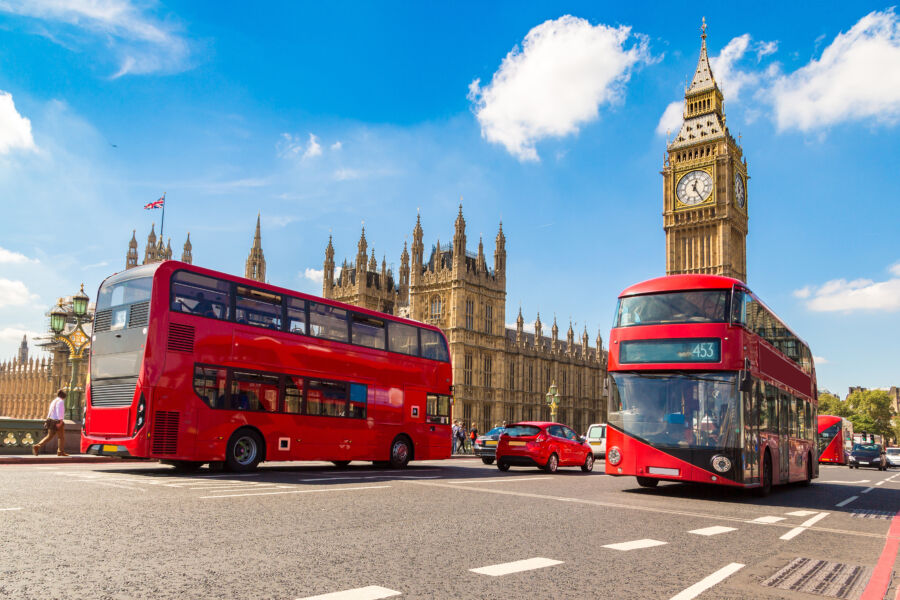
The famous red double-decker buses and iconic Underground system form the backbone of London’s transport network. The Tube covers 270 stations across 11 lines, running from early morning until midnight most days.
An Oyster card or contactless payment makes travel simple across buses, trains, and the Underground. Visitors can buy daily or weekly passes to save money on multiple journeys.
The city’s six major airports – Heathrow, Gatwick, Stansted, Luton, London City, and Southend – connect London to global destinations. Express trains link most airports to central London in under an hour.
Getting Around Edinburgh
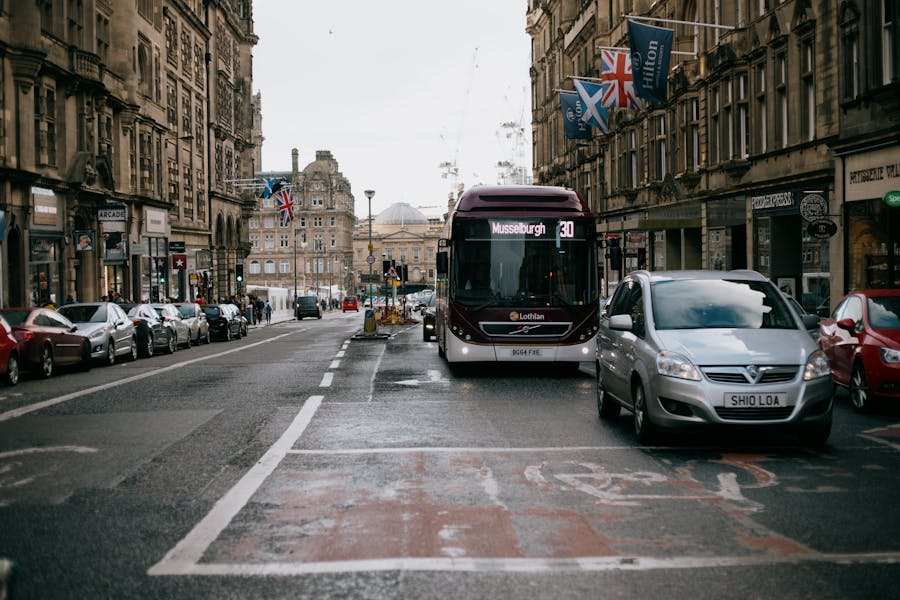
Edinburgh’s compact city center makes walking a practical option for many journeys. The modern tram system connects Edinburgh Airport to the city center in just 30 minutes.
Lothian Buses runs an efficient network of routes throughout the city. Day tickets offer unlimited travel on both buses and trams – perfect for reaching attractions like Arthur’s Seat.
The main train station, Edinburgh Waverley, sits right in the heart of the city between Old Town and New Town. Regular trains connect Edinburgh to other major UK cities.
The city’s dense European-style layout and well-maintained public transport make it easy to explore without a car. Most major attractions lie within walking distance of each other.
Parks and Nature
Both cities offer stunning green spaces where visitors can escape the urban bustle and connect with nature. London’s royal parks provide manicured gardens and recreational areas, while Edinburgh’s dramatic landscapes showcase Scotland’s raw natural beauty.
Green Spaces in London
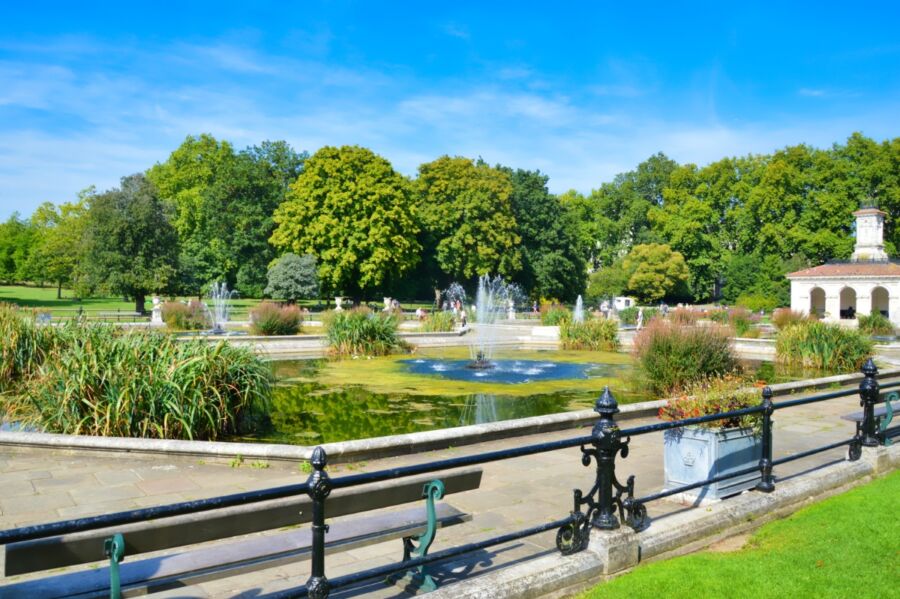
Hyde Park stands out as London’s most famous green space, spanning 350 acres in the heart of the city. Visitors can rent boats on the Serpentine lake or relax in a deck chair during summer months.
Kensington Gardens connects to Hyde Park and features the ornate Italian Gardens and the Peter Pan statue. The gardens offer a peaceful setting for picnics and afternoon strolls.
St. James’s Park provides picture-perfect views of Buckingham Palace. The park’s lake hosts pelicans that have lived there since the 1600s.
Edinburgh’s Natural Attractions
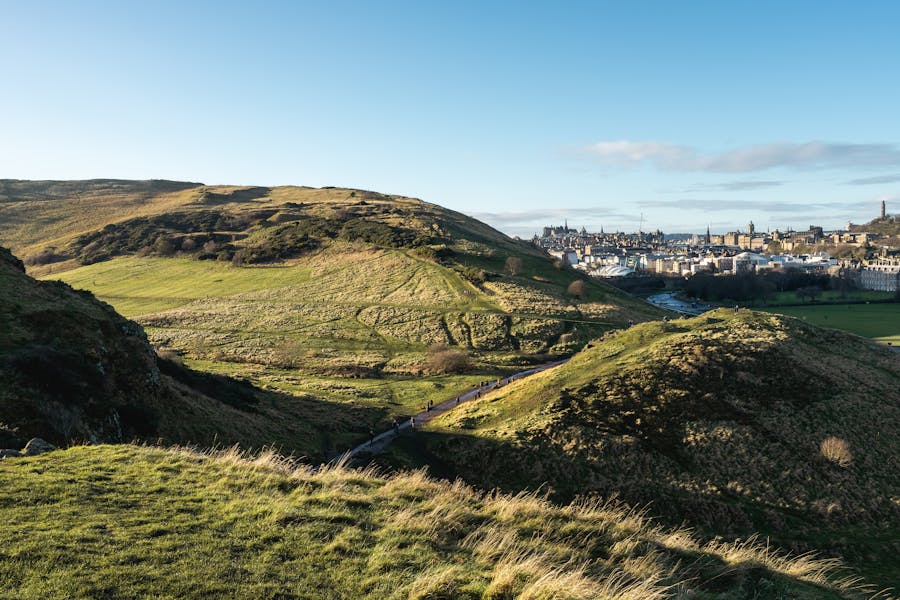
Arthur’s Seat, an ancient volcano rising 822 feet above sea level, dominates Edinburgh’s skyline. Visitors can hike to the top to enjoy panoramic views of the city and the Firth of Forth.
Holyrood Park surrounds Arthur’s Seat and covers 640 acres of hills, lochs, and cliffs. The park’s rugged terrain offers excellent spots for hiking and wildlife watching.
The Royal Botanic Garden Edinburgh spans 70 acres and houses over 13,000 plant species. Its Victorian glasshouses protect rare tropical plants and provide shelter on rainy days.
Frequently Asked Questions
London and Edinburgh differ significantly in lifestyle, cost, education, work, culture, and population density – key factors that shape daily life in these historic British cities.
What distinguishes living costs between London and Edinburgh?
Living costs in Edinburgh run about 30% lower than London. Rent for a one-bedroom flat in Edinburgh city center costs around £900, while similar flats in London often exceed £1,800.
Food, transport, and entertainment also cost less in Edinburgh. A monthly travel pass in Edinburgh costs £57, compared to London’s £140.
How do the university experiences in Edinburgh compare to those in London?
Edinburgh offers a more close-knit university community with most students living near campus. The University of Edinburgh ranks among the UK’s top institutions.
Meanwhile, London’s universities spread across the city, creating diverse student experiences. Students can access more internship opportunities but face higher living costs.
Which city should one choose for better employment opportunities, London or Edinburgh?
London dominates with more job openings across industries. The city hosts headquarters of major global companies and offers higher average salaries.
On the other hand, Edinburgh excels in finance, tech, and tourism sectors. The job market is smaller but less competitive, with strong growth in startups and tech companies.
In terms of cultural attractions and historical significance, how do London and Edinburgh differ?
Edinburgh’s compact size makes its historical sites easily accessible. The Royal Mile and Edinburgh Castle showcase medieval Scottish heritage.
Meanwhile, London’s museums, theaters, and landmarks span centuries of British history. The city offers more variety but requires more travel time between attractions.
Can you compare the quality of life in Edinburgh versus London?
Edinburgh residents enjoy shorter commute times and easier access to nature. The city ranks high for safety and community feel.
In contrast, London provides more entertainment options and career growth. Yet many residents face longer commutes and higher stress levels.
Is the size and population density of Edinburgh more appealing than London’s for relocation?
Edinburgh houses about 500,000 people compared to London’s 9 million. The smaller size means less crowding and easier navigation.
Edinburgh’s compact layout makes walking and cycling practical. Most amenities sit within a 20-minute walk in the city center.



